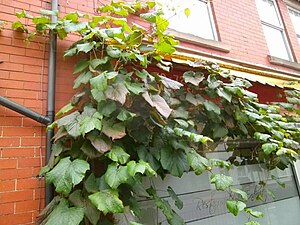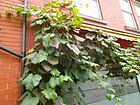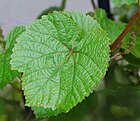Note: This is a project under development. The articles on this wiki are just being initiated and broadly incomplete. You can Help creating new pages.
Difference between revisions of "Vitis coignetiae - Crimson glory vine"
(Created page with "thumb|right|''Vitis coignetiae'', ''Crimson glory vine'' '''Vitis coignetiae''' ('''Crimson glory vine''', 머루 meoru in Korean), and...") |
(→Commonly seen growing in areas) |
||
| (12 intermediate revisions by 3 users not shown) | |||
| Line 1: | Line 1: | ||
[[File:Vitis coignetiae vine.jpeg|thumb|right|''Vitis coignetiae'', ''Crimson glory vine'']] | [[File:Vitis coignetiae vine.jpeg|thumb|right|''Vitis coignetiae'', ''Crimson glory vine'']] | ||
| − | '''Vitis coignetiae''' | + | '''Vitis coignetiae''' is a plant belonging to the genus Vitis that is native to the temperate climes of Asia, where it can be found in the Russian Far East, Korea and Japan. It was described botanically in 1883. |
| − | == | + | ==Uses== |
| + | {{Uses|Wounds}}, {{Uses|Cuts}}, {{Uses|Snakebites}}, {{Uses|Liver disorders}}, {{Uses|Skin eruptions}}, {{Uses|Blotches}}, {{Uses|Pimples}}, {{Uses|Diarrhea}}, {{Uses|Sore throats}} | ||
| − | + | ==Parts Used== | |
| + | {{Parts Used|Fruits}}, {{Parts Used|Leaves}}. | ||
| − | + | ==Chemical Composition== | |
| + | The total content of phenolic compounds was determined utilizing Folin-Ciocalteu's phenol reagent, while the content of tannins was assayed by the vanillin and BSA precipitation methods. Additionally, the DPPH free radical and ABTS cation radical scavenging activities and the reduction power of the extracts were measured. The HPLC method was applied to determine the phenolic compounds, such as phenolic acids and catechins<ref name="chemical composition"/> | ||
| − | == | + | ==Common names== |
| − | + | {{Common names|kn=|ml=|sa=|ta=|te=|hi=|en=Crimson glory vine}} | |
| − | |||
| − | + | ==Properties== | |
| + | Reference: Dravya - Substance, Rasa - Taste, Guna - Qualities, Veerya - Potency, Vipaka - Post-digesion effect, Karma - Pharmacological activity, Prabhava - Therepeutics. | ||
| + | ===Dravya=== | ||
| − | == References == | + | ===Rasa=== |
| − | + | Tikta (Bitter), Kashaya (Astringent) | |
| − | <references> | + | ===Guna=== |
| − | <ref name=" | + | Laghu (Light), Ruksha (Dry), Tikshna (Sharp) |
| + | ===Veerya=== | ||
| + | Ushna (Hot) | ||
| + | ===Vipaka=== | ||
| + | Katu (Pungent) | ||
| + | ===Karma=== | ||
| + | Kapha, Vata | ||
| + | ===Prabhava=== | ||
| + | |||
| + | ==Habit== | ||
| + | {{Habit|Deciduous Climber}} | ||
| + | |||
| + | ==Identification== | ||
| + | ===Leaf=== | ||
| + | {{Leaf|Simple|Alternate|The leaves are simple, rounded ovate, 10-25 cm wide}}<ref name="Leaf"/> | ||
| + | |||
| + | ===Flower=== | ||
| + | {{Flower|Unisexual|2-4cm long|Yellow|5-20|Flowers Season is June - August}} | ||
| + | |||
| + | ===Fruit=== | ||
| + | {{Fruit|General|10 mm|Fruits are thick, black|scarcely edible|-}} | ||
| + | |||
| + | ===Other features=== | ||
| + | |||
| + | ==List of Ayurvedic medicine in which the herb is used== | ||
| + | |||
| + | ==Where to get the saplings== | ||
| + | ==Mode of Propagation== | ||
| + | {{Propagation|Seeds}}, {{Propagation|Cuttings}}. | ||
| + | |||
| + | ==How to plant/cultivate== | ||
| + | Prefers a deep rich moist well-drained moderately fertile loam[1, 200]. Grows best in a calcareous soil[200]. Succeeds in sun or partial shade though a warm sunny position is required for the fruit to ripen<ref name="How to plant/cultivate"/> | ||
| + | |||
| + | ==Commonly seen growing in areas== | ||
| + | {{Commonly seen|Tall grasslands}}, {{Commonly seen|Meadows}}, {{Commonly seen|Borders of forests and fields}}. | ||
| + | |||
| + | ==Photo Gallery== | ||
| + | <gallery class="left" caption="" widths="140px" heights="140px"> | ||
| + | File:Vitis-coignetiae.JPG | ||
| + | File:Vitis coignetiae leaves.jpeg | ||
| + | File:Vitis coignetiae cluster.jpeg | ||
| + | File:Vitis coignetiae vine.jpeg | ||
| + | File:Vitis coignetiae feuille.jpg | ||
| + | </gallery> | ||
| + | |||
| + | ==References== | ||
| + | |||
| + | <references> | ||
| + | <ref name="chemical composition">[https://www.ncbi.nlm.nih.gov/pubmed/23493104 Chemical constituents]</ref> | ||
| + | |||
| + | <ref name="Leaf">[https://landscapeplants.oregonstate.edu/plants/vitis-coignetiae Plant descripiton]</ref> | ||
| + | |||
| + | <ref name="How to plant/cultivate">[https://www.pfaf.org/user/plant.aspx?latinname=Vitis+coignetiae Cultivation details"]</ref> | ||
</references> | </references> | ||
| − | == External Links == | + | ==External Links== |
| − | + | * [https://www.gardenia.net/plant/Vitis-Coignetiae-Crimson-Glory-Vine Vitis coignetiae on gardenia.net] | |
| − | *[https:// | + | * [https://www.rhs.org.uk/Plants/19030/i-Vitis-coignetiae-i/Details Vitis coignetiae on rhs.org.uk] |
| + | * [http://practicalplants.org/wiki/Vitis_coignetiae Vitis coignetiae on practicalplants.org] | ||
[[Category:Herbs]] | [[Category:Herbs]] | ||
| + | [[Category:Vitaceae]] | ||
Latest revision as of 11:11, 3 September 2020
Vitis coignetiae is a plant belonging to the genus Vitis that is native to the temperate climes of Asia, where it can be found in the Russian Far East, Korea and Japan. It was described botanically in 1883.
Contents
- 1 Uses
- 2 Parts Used
- 3 Chemical Composition
- 4 Common names
- 5 Properties
- 6 Habit
- 7 Identification
- 8 List of Ayurvedic medicine in which the herb is used
- 9 Where to get the saplings
- 10 Mode of Propagation
- 11 How to plant/cultivate
- 12 Commonly seen growing in areas
- 13 Photo Gallery
- 14 References
- 15 External Links
Uses
Wounds, Cuts, Snakebites, Liver disorders, Skin eruptions, Blotches, Pimples, Diarrhea, Sore throats
Parts Used
Chemical Composition
The total content of phenolic compounds was determined utilizing Folin-Ciocalteu's phenol reagent, while the content of tannins was assayed by the vanillin and BSA precipitation methods. Additionally, the DPPH free radical and ABTS cation radical scavenging activities and the reduction power of the extracts were measured. The HPLC method was applied to determine the phenolic compounds, such as phenolic acids and catechins[1]
Common names
| Language | Common name |
|---|---|
| Kannada | |
| Hindi | |
| Malayalam | |
| Tamil | |
| Telugu | |
| Marathi | NA |
| Gujarathi | NA |
| Punjabi | NA |
| Kashmiri | NA |
| Sanskrit | |
| English | Crimson glory vine |
Properties
Reference: Dravya - Substance, Rasa - Taste, Guna - Qualities, Veerya - Potency, Vipaka - Post-digesion effect, Karma - Pharmacological activity, Prabhava - Therepeutics.
Dravya
Rasa
Tikta (Bitter), Kashaya (Astringent)
Guna
Laghu (Light), Ruksha (Dry), Tikshna (Sharp)
Veerya
Ushna (Hot)
Vipaka
Katu (Pungent)
Karma
Kapha, Vata
Prabhava
Habit
Identification
Leaf
| Kind | Shape | Feature |
|---|---|---|
| Simple | Alternate | The leaves are simple, rounded ovate, 10-25 cm wide |
Flower
| Type | Size | Color and composition | Stamen | More information |
|---|---|---|---|---|
| Unisexual | 2-4cm long | Yellow | 5-20 | Flowers Season is June - August |
Fruit
| Type | Size | Mass | Appearance | Seeds | More information |
|---|---|---|---|---|---|
| General | 10 mm | Fruits are thick, black | scarcely edible | - | {{{6}}} |
Other features
List of Ayurvedic medicine in which the herb is used
Where to get the saplings
Mode of Propagation
How to plant/cultivate
Prefers a deep rich moist well-drained moderately fertile loam[1, 200]. Grows best in a calcareous soil[200]. Succeeds in sun or partial shade though a warm sunny position is required for the fruit to ripen[3]
Commonly seen growing in areas
Tall grasslands, Meadows, Borders of forests and fields.
Photo Gallery
References
External Links
- Ayurvedic Herbs known to be helpful to treat Wounds
- Ayurvedic Herbs known to be helpful to treat Cuts
- Ayurvedic Herbs known to be helpful to treat Snakebites
- Ayurvedic Herbs known to be helpful to treat Liver disorders
- Ayurvedic Herbs known to be helpful to treat Skin eruptions
- Ayurvedic Herbs known to be helpful to treat Blotches
- Ayurvedic Herbs known to be helpful to treat Pimples
- Ayurvedic Herbs known to be helpful to treat Diarrhea
- Ayurvedic Herbs known to be helpful to treat Sore throats
- Herbs with Fruits used in medicine
- Herbs with Leaves used in medicine
- Herbs with common name in English
- Habit - Deciduous Climber
- Index of Plants which can be propagated by Seeds
- Index of Plants which can be propagated by Cuttings
- Herbs that are commonly seen in the region of Tall grasslands
- Herbs that are commonly seen in the region of Meadows
- Herbs that are commonly seen in the region of Borders of forests and fields
- Herbs
- Vitaceae





